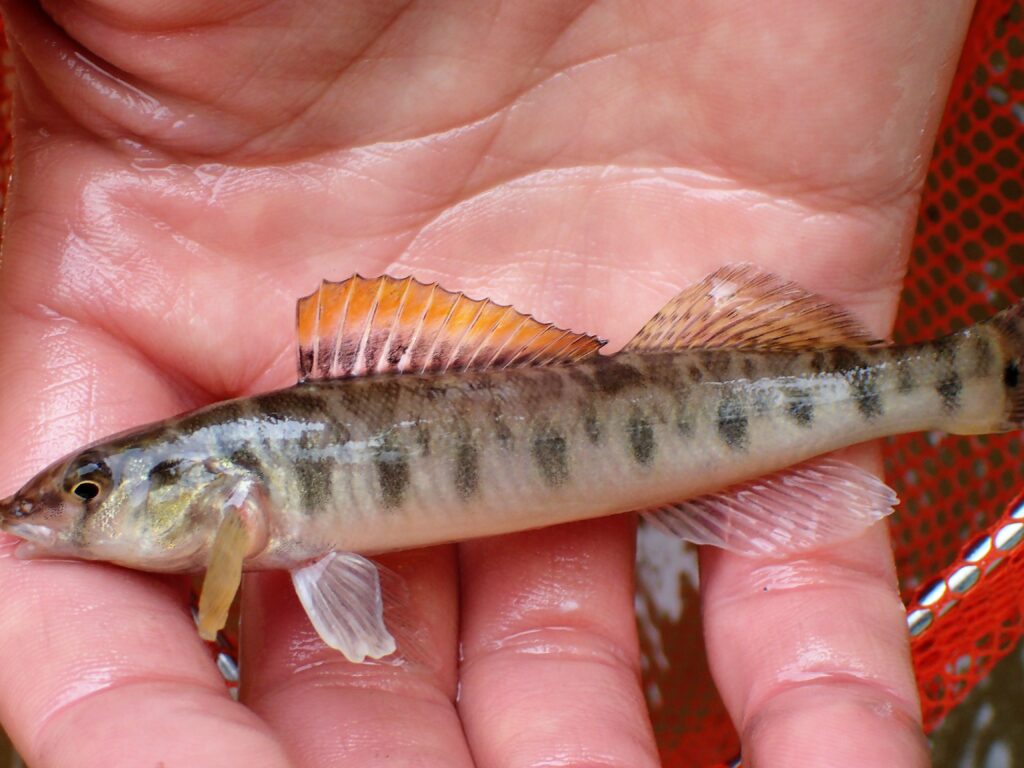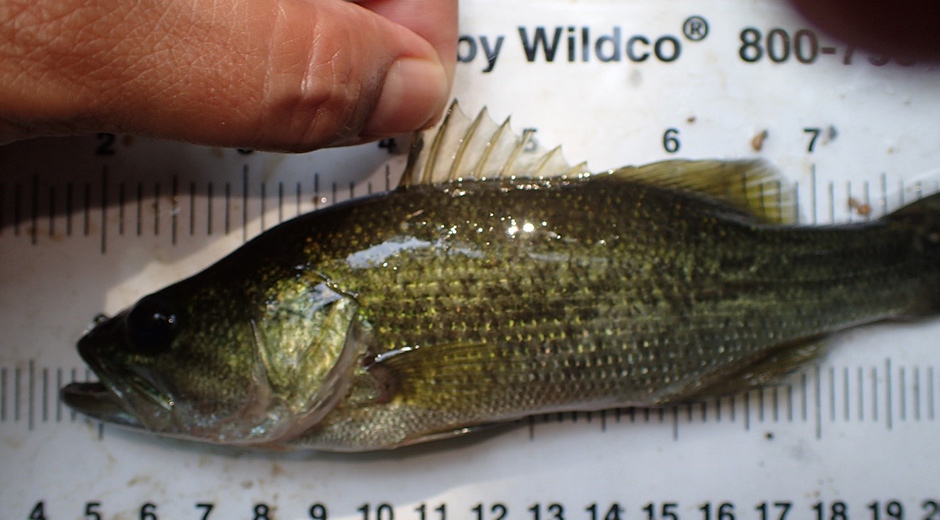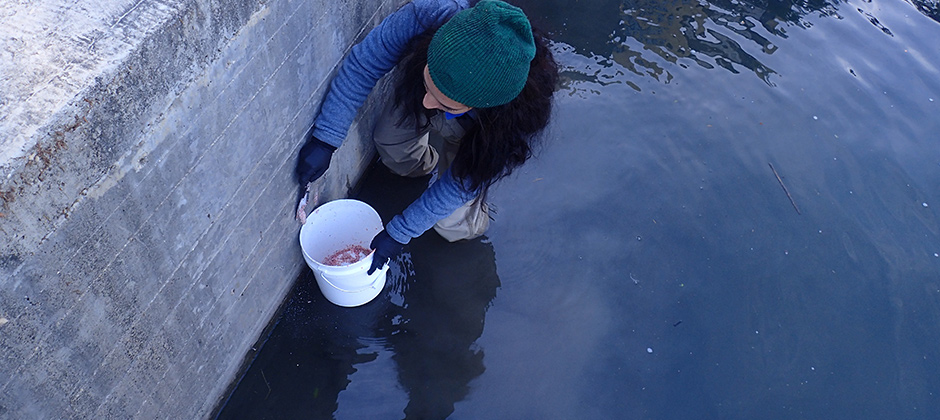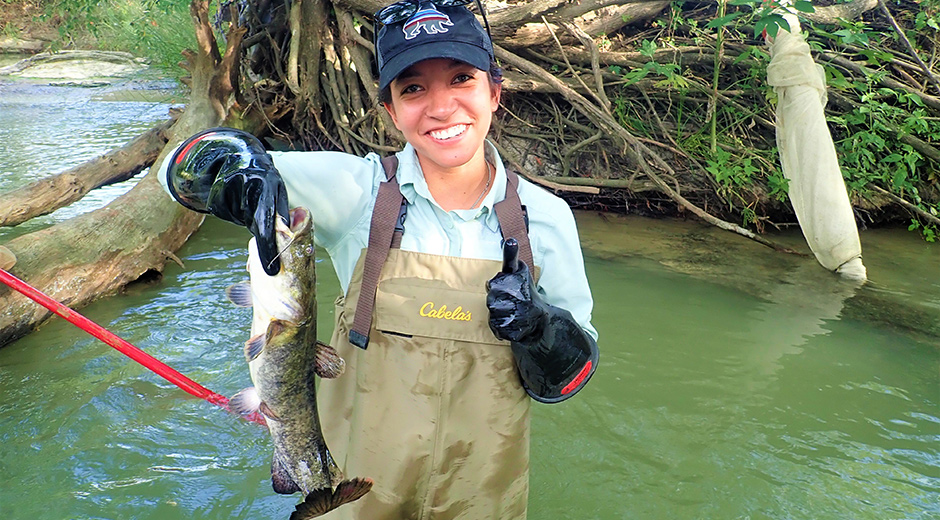
While all the metrics in the San Antonio River Basin Report Card have overlapping correlation to the safe, clean, enjoyable creeks and rivers aspects of the River Authority’s mission, the Index of Biotic Integrity grade is primarily related to the clean aspect.
The Index of Biotic Integrity (IBI) is designed as a way for River Authority Environmental Sciences Department (ESD) staff to sample, evaluate, and describe the condition of creeks and rivers throughout the basin. These metrics reflect fish species richness, trophic level composition (e.g., predators and omnivores), number and abundance of species, and condition of individual fish among other aspects of the overall fish community. These metrics are then combined and assessed based on a waterbody’s Designated Aquatic Life Use (ALU) as assigned by the Texas Commission on Environmental Quality (TCEQ) and Environmental Protection Agency (EPA), and can fall into one of five categories: Minimal, Limited, Intermediate, High, and Exceptional. Theoretically, the less disturbed a stream is, the higher the IBI rating will be. River Authority biologists are constantly monitoring the San Antonio River Basin at numerous sites throughout the watershed to evaluate IBI.
Grade for 2022:
B-
How is this being measured?
To determine the IBI grade for the 2022 San Antonio River Basin Report Card, we will use the last three years of data for each of the 17 sites monitored throughout the basin by the River Authority. Last year these metrics were calculated based on 20 sites. These measurements are done on a 3-year rolling average, and three sites that were assessed last year did not have data for the updated 3-year time frame. The River Authority adds or drops monitoring stations for a myriad of reasons including special studies based on watershed conditions starting or stopping, a more representative site is found within a waterbody, or site accessibility issues.
The grade will be determined by the number of sites meeting the designated ALU divided by the total number of sites monitored, multiplied by 100. Therefore, the grade for this metric is based on the percentage of monitored sites that meet the ALU designation.
Explanation of the Grade
There are 11 of 17 sites achieving the associated ALU designation:
11/ 17 * 100 = 64.7%
Grade: B-
Key Findings
This grade indicates that some of the creeks and rivers of the San Antonio River Basin have healthy fish communities. However, the score does indicate that further improvements can be made to enhance the diversity and abundance of these communities throughout the basin. Reducing disturbances to area creeks and rivers can help protect and enhance the health of their biotic communities. Healthy ecosystems are more resilient to existing disturbances and are characterized by high species diversity. A healthy San Antonio River Basin is a benefit not only for the aquatic communities that inhabit its waters, but it is also a valuable amenity for all residents of the basin.

Recommended Actions
Though many factors contribute to the health of aquatic populations, there are actions that you can take to do your part to contribute to a healthy, diverse aquatic environment. The first recommended action citizens can take is to learn more about the health of the San Antonio River Basin.
The San Antonio River Basin Summary Report, which is completed every five years, provides an overview of monitoring and assessment activities in the San Antonio River Basin, as well as a deep dive into the environmental monitoring data collected by the River Authority. The 2018 report was prepared by River Authority staff in coordination with the Texas Commission on Environmental Quality (TCEQ) and in accordance with the state’s guidelines. The report presents a 10-year history of the levels of bacteria, nutrients, aquatic life use, and other water quality parameters at more than 180 sites throughout six watersheds in the basin, covering various periods. The 2023 Basin Summary Report will be available in June 2023.
The Basin Highlight Reports provide annual updates of the findings and activities conducted by the River Authority for the San Antonio River Basin in cooperation with the TCEQ under the State of Texas Clean Rivers Program (CRP). The 2022 report includes an overview of basin water quality monitoring activities; a review of water quality data; a discussion of activities and findings for special studies; maps showing the location of sampling sites; a discussion of participation of other organizations in the basin monitoring program; and public outreach activities.
Learn more about the State of Texas Clean Rivers Program.

The next recommended action citizens can take is to please remember, never dump your aquarium into the river or any other freshwater or saltwater body. The River Authority is currently responding to invasive apple snails that have been found in the San Antonio River Walk. This invasive species has unfortunately been carelessly introduced into our basin from people who have illegally dumped their fish tanks into the river. These snails have few native predators and are voracious herbivores. If they were to establish in the Mission Reach (or anywhere further south, including the lower basin), they would pose a threat. Therefore, our experts are trying to eliminate them where they have been spotted in the Museum Reach and downtown sections of the River Walk.
If you boat in Texas, including kayaking or canoeing on the San Antonio River, you can help stop the spread of the invasive Zebra mussel, which over this past year, have now been identified as being established in Medina Lake within the San Antonio River Basin.
Other actions citizens can take is to sign the pledge to reduce trash in your local creek or river; report illegal dumping to the River Authority’s environmental investigators; or support on-site stormwater treatment by installing rain gardens and other green infrastructure features, which are types of multi-benefit best management practices that help reduce flooding and improve water quality in area creeks and rivers.
Grade for 2021:
C+
How is this being measured?
To determine the IBI grade for the 2021 San Antonio River Basin Report Card, we will use last five years of data for each of the 20 sites monitored throughout the basin by the River Authority. Last year these metrics were calculated based on 21 sites. These measurements are done on a 3-year rolling average, and one site that was assessed last year did not have data for the updated 3-year time frame.
The grade will be determined by the number of sites meeting designated ALU divided by total number of sites monitored, multiple 100. Therefore, the grade for this metric is based on the percentage of monitored sites that meet the ALU designation.
Explanation of the Grade
There are 11 of 20 sites achieving the associated ALU designation:
Grade: C +
(11 / 20 * 100 = 55.0 %)
Key Findings
This grade indicates that some of the creeks and rivers of the San Antonio River Basin have healthy fish communities. However, the score does indicate that further improvements can be made to enhance the diversity and abundance of these communities throughout the basin. Reducing disturbances to area creeks and rivers can help protect and enhance the health of their biotic communities. Healthy ecosystems are more resilient to existing disturbances and are characterized by high species diversity. A healthy San Antonio River Basin is a benefit not only for the aquatic communities that inhabit its waters, but it is also a valuable amenity for all residents of the basin.

Recommended Actions
Though many factors contribute to the health of aquatic populations, there are actions that you can take to do your part to contribute to a healthy, diverse aquatic environment. The first recommended action citizens can take is to learn more about the health of the San Antonio River Basin.
The San Antonio River Basin Summary Report, which is completed every five years, provides an overview of monitoring and assessment activities in the San Antonio River Basin. The 2018 report was prepared by River Authority staff in coordination with the Texas Commission on Environmental Quality (TCEQ) and in accordance with the state’s guidelines. The report presents a 10-year history of the levels of bacteria, nutrients, aquatic life use, and other water quality parameters at more than 180 sites throughout six watersheds in the basin, covering various periods.
The Basin Highlights Report provides annual updates of the findings and activities conducted by the River Authority for the San Antonio River Basin in cooperation with the TCEQ under the State of Texas Clean Rivers Program (CRP). The 2021 report includes an overview of basin water quality monitoring activities; a review of water quality data; a discussion of activities and findings for special studies; maps showing the location of sampling sites; a discussion of participation of other organizations in the basin monitoring program; and public outreach activities.
Learn more about the State of Texas Clean Rivers Program.

The next recommended action citizens can take is to please remember, never dump your aquarium into the river or any other freshwater or saltwater body. The River Authority is currently responding to invasive apple snails that have been found in the San Antonio River Walk. This invasive species has unfortunately been carelessly introduced into our basin from people who have illegally dumped their fish tanks into the river. These snails have few native predators and are voracious herbivores. If they were to establish in the Mission Reach (or anywhere further south, including the lower basin), they would pose a threat. Therefore, our experts are trying to eliminate them where they have been spotted in the Museum Reach and downtown sections of the River Walk.
If you boat in Texas, including kayaking or canoeing on the San Antonio River, you can help stop the spread of the invasive Zebra mussel, which over this past year, have now been identified as being established in the Medina Lake within the San Antonio River Basin.
Other actions citizens can take is to sign the pledge to reduce trash in your local creek or river; report illegal dumping to the River Authority’s environmental investigators; or support on-site stormwater treatment by installing rain gardens and other green infrastructure features, which are types of multi-benefit best management practices that help reduce flooding and improve water quality in area creeks and rivers.
Grade for 2020:
C
How is this being measured?
To determine the IBI grade for the 2020 San Antonio River Basin Report Card, we will use last five years of data for each of the 21 sites monitored throughout the basin by the River Authority. The grade will be determined by the number of sites meeting designated ALU divided by total number of sites monitored, multiple 100. Therefore, the grade for this metric is based on the percentage of monitored sites that meet the ALU designation.
Explanation of the Grade
There are 11 of 21 sites achieving the associated ALU designation:
Grade: C
(11 / 21 * 100 = 52.4%)
Key Findings
This grade indicates that some of the creeks and rivers of the San Antonio River Basin have healthy fish communities. However, the score does indicate that further improvements can be made to enhance the diversity and abundance of these communities throughout the basin. Reducing disturbances to area creeks and rivers can help protect and enhance the health of their biotic communities. Healthy ecosystems are more resilient to existing disturbances and are characterized by high species diversity. A healthy San Antonio River Basin is a benefit not only for the aquatic communities that inhabit its waters, it is a valuable amenity for all residents of the basin.

Recommended Actions
Though many factors contribute to the health of aquatic populations, there are actions that you can take to do your part to contribute to a healthy, diverse aquatic environment. The first recommended action citizens can take is to learn more about the health of the San Antonio River Basin.
The San Antonio River Basin Summary Report, which is completed every five years, provides an overview of monitoring and assessment activities in the San Antonio River Basin. The 2018 report was prepared by River Authority staff in coordination with the Texas Commission on Environmental Quality (TCEQ) and in accordance with the state’s guidelines. The report presents a 10-year history of the levels of bacteria, nutrients, aquatic life use, and other water quality parameters at more than 180 sites throughout six watersheds in the basin, covering various periods.
The Basin Highlights Report provides annual updates of the findings and activities conducted by the River Authority for the San Antonio River Basin in cooperation with the TCEQ under the State of Texas Clean Rivers Program (CRP). The 2020 report includes an overview of basin water quality monitoring activities; a review of water quality data; a discussion of activities and findings for special studies; maps showing the location of sampling sites; a discussion of participation of other organizations in the basin monitoring program; and public outreach activities.
Learn more about the State of Texas Clean Rivers Program.

The next recommended action citizens can take is to please remember, never dump your aquarium into the river or any other freshwater or saltwater body. The River Authority is currently responding to invasive apple snails that have been found in the San Antonio River Walk. This invasive species has unfortunately been carelessly introduced into our basin from people who have illegally dumped their fish tanks into the river. These snails have few native predators and are voracious herbivores. If they were to establish in the Mission Reach (or anywhere further south, including the lower basin), they would pose a threat. Therefore, our experts are trying to eliminate them where they have been spotted in the Museum Reach and downtown sections of the River Walk.
If you boat in Texas, including kayaking or canoeing on the San Antonio River, you can help stop the spread of the invasive Zebra mussel.
Other actions citizens can take is reduce bacteria in your local creek or river by picking up your pet waste; report illegal dumping to the River Authority’s environmental investigators; or support on-site stormwater treatment by installing rain gardens and other green infrastructure features.


